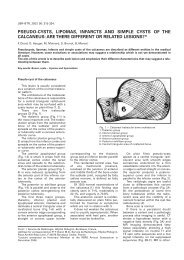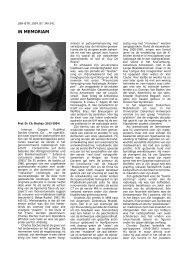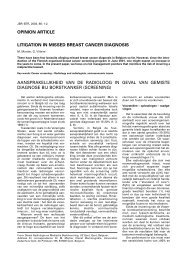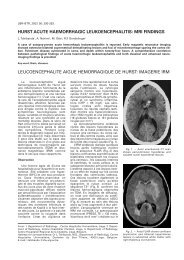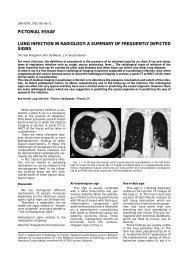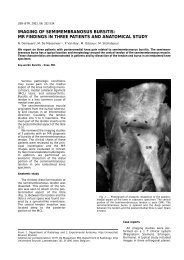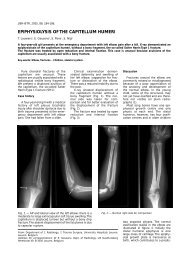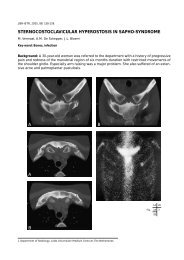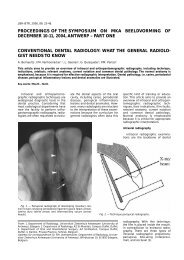review article picture archiving and communication system - rbrs
review article picture archiving and communication system - rbrs
review article picture archiving and communication system - rbrs
Create successful ePaper yourself
Turn your PDF publications into a flip-book with our unique Google optimized e-Paper software.
244 JBR–BTR, 2004, 87 (5)<br />
trains an in-house resource, who<br />
then is responsible for training inhouse<br />
staff (14).<br />
Information <strong>system</strong> integration<br />
It is necessary to determine the<br />
requirements <strong>and</strong> costs of interfacing<br />
PACS with existing applications<br />
on the current network. Specification<br />
of the network <strong>communication</strong><br />
infrastructure, either existing or<br />
new, <strong>and</strong> inclusion of wide-area network<br />
connectivity to clinics <strong>and</strong><br />
physician offices or homes, based<br />
on required transfer times, availability,<br />
reliability <strong>and</strong> cost are other<br />
important issues. Furthermore, the<br />
make <strong>and</strong> versions of HIS <strong>and</strong> RIS<br />
<strong>and</strong> current enterprise security protocols<br />
must be known.<br />
PACS component requirements<br />
report<br />
A PACS component requirements<br />
report lists the PACS equipment by<br />
component <strong>and</strong> the integration<br />
requirements to meet a desired<br />
quality of implementation. What are<br />
the requirements for each major<br />
function? For example, what are the<br />
important functions for a workstation:<br />
image manipulation <strong>and</strong> processing,<br />
supported “hanging” protocols<br />
depending on the application,<br />
image quality, number of screens,<br />
performance? The same applies for<br />
the archive <strong>and</strong> database management<br />
<strong>system</strong> – what is the required<br />
capacity, the access time, workflow<br />
support (pre-fetching), <strong>and</strong> performance<br />
st<strong>and</strong>ards? Surveying the<br />
marketplace will provide current<br />
trends <strong>and</strong> changes in technology<br />
that should be included, such as<br />
changes in archive long-term storage<br />
media. The report outlines the<br />
required storage, network, functionality,<br />
integration, <strong>and</strong> network<br />
performance requirements <strong>and</strong> provides<br />
the requirements needed to<br />
write the request for information<br />
(RFI) <strong>and</strong> request for proposal (RFP).<br />
Physical needs<br />
Physical layout is often an overlooked<br />
aspect of PACS projects.<br />
Details of room design, storage,<br />
lighting <strong>and</strong> <strong>communication</strong>s needs<br />
have a tremendous impact on effective<br />
utilization. A functional analysis<br />
of the PACS project with evaluation<br />
of the actual layout may help for<br />
finalizing design details. Having the<br />
proper room design <strong>and</strong> comparing<br />
it to the required functions <strong>and</strong> work<br />
flow will be crucial in enabling the<br />
equipment to be properly utilized.<br />
Outline business case<br />
PACS <strong>system</strong>s can range from<br />
hundreds of thous<strong>and</strong>s to millions<br />
of Euros. Developing a realistic budget<br />
that is adequate, not only to<br />
cover initial installation <strong>and</strong> start-up<br />
costs, but for the life of the <strong>system</strong> is<br />
necessary for successful PACS<br />
implementation (5,6,11,15). A successful<br />
business case compares the<br />
cost of operations in a film environment<br />
with the projected costs in a<br />
PACS environment. It is important to<br />
create a budget based on what is<br />
currently spend on film, film processing<br />
<strong>and</strong> h<strong>and</strong>ling, full-time<br />
equivalents, capital equipment that<br />
will need to be replaced if not buying<br />
PACS, storage costs/restraints,<br />
as well as growth of the department<br />
<strong>and</strong> available capital. Projections<br />
should also include all hidden costs,<br />
such as facilities remodelling, telephone<br />
<strong>and</strong> modem capability. The<br />
costs of capital equipment<br />
upgrades, to meet DICOM compliance<br />
st<strong>and</strong>ards or to enable the creation<br />
of modality work lists, must be<br />
accounted for. The equipment costs<br />
for workstations, servers, brokers,<br />
archives, digitizers <strong>and</strong> viewing stations<br />
must be calculated. Network<br />
creation <strong>and</strong> maintenance will also<br />
have assigned costs. An oftenignored<br />
issue is the human resource<br />
allocation that is required to implement,<br />
maintain <strong>and</strong> upgrade the<br />
<strong>system</strong>. Who will cover cost overruns<br />
for installation, service or<br />
upgrades, if they occur? Three prime<br />
areas need to be investigated: cost<br />
avoidance, productivity gains, <strong>and</strong><br />
revenue-generation opportunities.<br />
The cost per examination is calculated<br />
with the supplies, staff, <strong>and</strong> service<br />
costs in both environments.<br />
Unrealistic claims must be avoided<br />
regarding improved throughput <strong>and</strong><br />
reductions in staffing <strong>and</strong> expenses.<br />
Perhaps those could be achieved<br />
under ideal conditions elsewhere,<br />
but whether or not they can be<br />
achieved at your institution is key.<br />
Attempt to undersell, or at least conservatively<br />
sell, what will be<br />
achieved so expectations can be<br />
met or exceeded. Overselling has<br />
two very serious results. One is that<br />
you have doomed the project to failure.<br />
The second is that it will be<br />
much more difficult for you to gain<br />
approval for future requests (15).<br />
The scope of the project <strong>and</strong> capital-financing<br />
plan will impact the<br />
business case outcome. Consider<br />
the following three payment methods:<br />
a capital purchase, an operating<br />
lease, <strong>and</strong> an application service<br />
provider. The method of payment<br />
chosen affects the business plan significantly<br />
(6).<br />
The business case is critical for<br />
senior administration approval to<br />
implement PACS.<br />
Investigation stage<br />
Share information<br />
The more information shared<br />
between the institution <strong>and</strong> the<br />
potential vendors, the better off<br />
everyone will be (14). If a vendor<br />
does not know exactly what the<br />
objectives are – what the new acquisition<br />
needs to achieve <strong>and</strong> the characteristics<br />
of the institution – the<br />
proposed <strong>system</strong> cannot be expected<br />
to meet the specified needs. It is<br />
essential to share as much information<br />
as possible.<br />
What is the problem to be<br />
solved? The introduction of any RFP<br />
should state objectives, such as<br />
eliminating film loss, increasing<br />
turnaround time, simultaneous<br />
access in the intensive care unit,<br />
emergency radiology or radiology<br />
department to increase efficiency,<br />
etc. In addition, one should list hospital<br />
characteristics, such as the<br />
number of its procedures,<br />
images/exams, a complete list of<br />
acquisition modalities <strong>and</strong> its<br />
expected growth rate. Further, clinical<br />
scenarios, from patient entry<br />
through discharge within radiology,<br />
are important so that a vendor can<br />
match the workflow.<br />
The investigation of options is<br />
probably the most time-consuming<br />
portion of the analysis. It is in this<br />
stage that the <strong>system</strong> architecture is<br />
drafted. This draft is both determined<br />
<strong>and</strong> refined by input from<br />
multiple individuals <strong>and</strong> groups.<br />
Important contributions must be<br />
solicited from the information technology<br />
division, radiologists <strong>and</strong><br />
other physicians, hospital administration<br />
<strong>and</strong> any other service where<br />
the use of imaging technology information<br />
is required <strong>and</strong> beneficial.<br />
Vendors <strong>and</strong> consultants may be<br />
extremely valuable in generating<br />
workflow diagrams, which include<br />
imaging acquisition components<br />
<strong>and</strong> imaging display components<br />
(11).<br />
Request for information<br />
A well-designed RFI may be a<br />
means to meeting the various needs<br />
for successful PACS implementation.<br />
A detailed inventory of imaging<br />
equipment, imaging equipment



